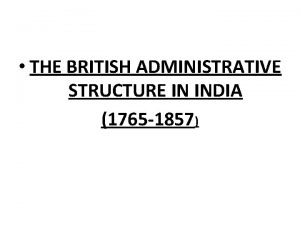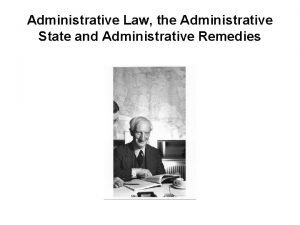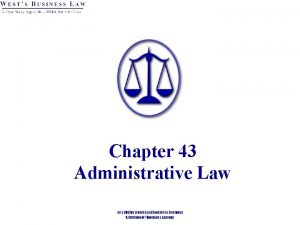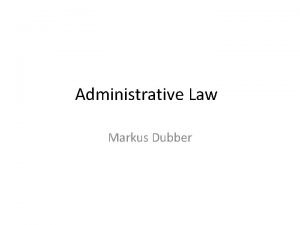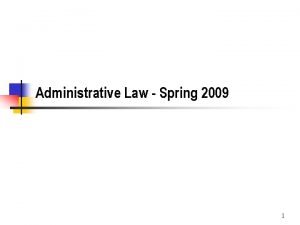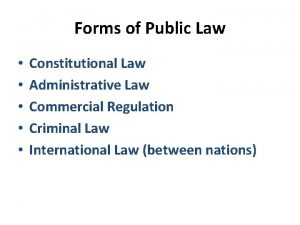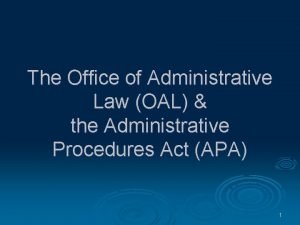INTRODUCTION TO ADMINISTRATIVE LAW 1 Administrative law is











- Slides: 11

INTRODUCTION TO ADMINISTRATIVE LAW

1. Administrative law is being taught in many institutions of higher education as well as in numeorus special institutes. 2. For a long time administrative law has been a subject of research and it becomes more and more popular as a subject of teaching. 3. The role of administrative law in contemporary states and society is so great and obvious that it seems to be needless to develop any further arguments to prove it.

4. A modern state cannot function without adm. law and also public administration cannot function without administrative law. 5. Administrative law involves the study of how those parts of our system of government that are neither legislatures nor courts make decisions. These entities, referred to as administrative bodies, are normally located in the executive branch of government and are usually charged with the day–to–day details of governing. 6. According to Professor T. Rakoff from Harvard Law School ’Administrative law…[controls] how government operates. ’

Administrative law: 1. is the most extensive and flexible body of law controlling the legal situation of both individuals and almost all other subjects operating within the state 2. it usually contains imperative norms (absolutely binding norms – ius cogens) 3. is usually supported by public power 4. has a broad scope and is difficult to codify 5. has rules which are inserted in acts of different rank, enacted by various organs, in different periods of time 6. is not politically neutral (in the words of Ronald Dworkin it is a political enterprise) 7. it is difficult to interpret norms of administrative law 8. this branch of law includes local law binding on the territory of the organ issuing it.

Internal division of administrative law Administrative law Structural a. l. (who is acting? ) Substantive a. l. (what is the object of the action? ) Procedural a. l. (how are they acting? )

MAJOR FIELDS OF ADMINISTRATIVE LAW: 1. Organizational administrative law, concerning the organization of administrative authorities, institutions and agencies, as well as rules regulating the distribution of tasks and competences, and is linked with civil service law; 2. Substantive administrative law, concerning the competences of specific entities of administration involving the rights of citizens, as well as rights and obligations of citizens; 3. Formal administrative law, called administrative procedure, is concerned with developing rules and procedures for administrative agencies or administrative courts.

THE NATURE OF ADMINISTRATIVE LAW § Adm. law in its modern form is a relatively young branch of law. § Administrative law evolved into a modern branch of law at the turn of 19 th century. § The idea of creating this branch of law was to protect people from arbitrary action of public authorities. § Public law in the modern concept which offers an account in governing authority in legal terms and is formed by reworking the medieval idea of the sovereign state. The nature of the concept is explain mainly through examination of the writing of Bodin, Pufendorf and Rousseau.

DOMESTIC AND EUROPEAN ADMINISTRATIVE LAW: v domestic administrative law is founded on one, and single authority, the Government. EU administrative law, on the other hand, recognizes two authorities, the Council and the Commission, which preside over the public administration at the EU level; the composition of the EU is complex, as it combines both European and national/domestic (i. e. of member-states) administrative bodies; v domestic administrative law is characterized by a bi-polar relationship between the citizen and the Administration. The European administrative law is characterized by a tri-polar relationship, between citizens, the Commission and the national governments;

DOMESTIC AND EUROPEAN ADMINISTRATIVE LAW: v domestic administrative law forms a special branch of law, and public administration may impose it directly, while the enforcement of European administrative law is guaranteed either through the jurisprudence of the ECJ or with the assistance of member-states’ public administration. v domestic administrative law is based on the national/domestic Constitution, and the legal order that it [the Constitution] describes. The European administrative law, due to the lack of a Constitution, draws its constitutional foundations from the Treaties, the general principles of law and the common legal traditions of member-states in the area of administrative law.

GLOBAL AND DOMESTIC ADMINISTRATIVE LAW: v they both regulate the relations of an organization with regulatory competences and powers, that issues decisions and acts (or omissions) directed both to its members but also to third parties, while there is also a – more or less developed- system of judicial review and protection for resolving or mediating disputes arising from the operation of the organization.

The presentation is based on: 1. Administrative law and Policy of the European Union, Hoffman H. C. H. , Rowe G. C. , Türk A. , Oxford University Press 2012. 2. Duniewska Z. , Administrative law, [in: ] Introduction to Polish law, Wyrozumska A. , (ed. ), Łódź 2005. 3. Metzler E. L. , The Growth and Development of Administrative. Law, available at: http: //scholarship. law. marquette. edu/cgi/viewcontent. cgi? article=3911&context= mulr 4. Możdzeń-Marcinkowski M. , Introduction to Polish administrative law, Second revised edition, C. H. Beck, Warszawa 2012.
 Administrative law
Administrative law Nature of administrative law
Nature of administrative law Adl 2601
Adl 2601 Newton's first law and second law and third law
Newton's first law and second law and third law Newton's first law and second law and third law
Newton's first law and second law and third law Boyles law
Boyles law Boyle's law charles law avogadro's law
Boyle's law charles law avogadro's law Intro paragraph layout
Intro paragraph layout Administrative supplement nih
Administrative supplement nih Example of administrative records
Example of administrative records Administrative stuff
Administrative stuff The british administrative structure in india(1765-1857)
The british administrative structure in india(1765-1857)











